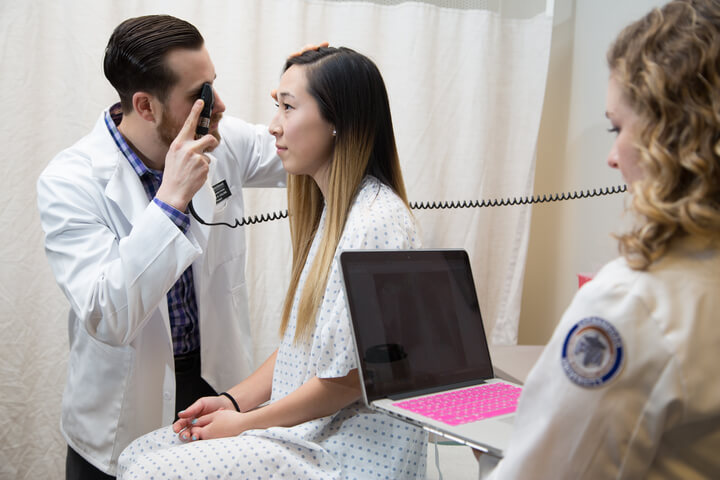Graduating students trained in Shenandoah’s health professions programs are performing extremely well on their certification exams.
The most recent group of graduates of the Bernard J. Dunn School of Pharmacy – 108 – surpassed the national average for first-time test takers on the North American Pharmacist Licensure Examination (NAPLEX). According Pharmacy Times, only 20 schools “achieved a score of 94.4 percent or higher…. Of these 20, only seven schools achieved a first-time pass rate equal to or higher in 2016 compared to their 2015 performance.” Shenandoah is one of these seven high-performing schools, with a 2016 NAPLEX pass rate of 94.44 percent.
It’s important to note that Shenandoah pharmacy school students continue to perform well above the national average, in spite of a recent 2016 change in the NAPLEX exam format, which caused a dramatic decline in national pass rates “from an average first-pass rate of about 92 percent down to a surprising 86.1 percent,” according to Pharmacy Times.
The physical therapy program saw a first-time board pass rate of 97 percent for 2016, and 95 percent in 2015, with an ultimate pass rate of 100 percent for graduates taking the National Physical Therapy Exam in both years. The program’s graduates consistently perform above the national average, which was 91 percent for U.S. students, according to the Federation of State Boards of Physical Therapy. Associate Professor and Interim Director of Physical Therapy Sheri Hale, PT, Ph.D., ATC, thinks several factors contribute to the program’s great success, including “1) the rigor of the program, 2) the comprehensive nature of our clinical education program and the quality of our clinical education sites, 3) collaborative culture of the program and 4) our curricular structure including capstone experiences.”
The first-time pass rate for the physician assistant studies program in 2014 and 2015 (the most recent years for which figures are available) was 100 percent, compared to a 96 percent rate nationwide on the Physician Assistant National Certifying Exam. Division of Physician Assistant Studies Distinguished Professor and Director Anthony A. Miller, M.Ed., PA-C, attributes the program’s success to “outstanding faculty including our community clinical preceptors, quality curriculum, and awesome dedicated, hard-working students.” Additionally, he said the program does not “‘teach to the test,’ we teach so that our graduates are competent and caring providers of health care to patients and their families.”
Shenandoah’s occupational therapy program also has top marks for graduates taking the National Board of Certification in Occupational Therapy (NBCOT) exam, with a 2016 pass rate of 97 percent with 30 students taking the exam. All students in Shenandoah’s program complete a prep exam during the Occupational Therapy Gate Week, when students return from experiential learning to meet as a large group.
As for athletic training (AT), it has seen a 100 percent pass rate over the past five years, against a national three-year pass rate of 91 percent for first-time Board of Certification exam takers and 97 percent for overall test takers, according to the Commission on Accreditation of Athletic Training Education. According to Shenandoah’s Director of Athletic Training, Rose Schmieg, DHSc, ATC, PT, OCS, CSCS, the exam covers five domains: 1) Injury/Illness Prevention and Wellness, 2) Clinical Evaluation and Diagnosis, 3) Immediate and Emergency Care, 4) Treatment and Rehabilitation, and 5) Organizational and Professional Health and Well-being. Shenandoah’s AT program has consistently used the exam results to improve itself. “Over the years, successful program adjustments have included having our staff athletic trainers and local secondary school athletic trainers provide live seminars on emergency care, and collaborating with the nursing and respiratory care program and the conservatory’s theatre program to provide interprofessional, standardized patient case events to practice clinical diagnosis and interprofessional communication skills,” Schmieg said. “It’s a tough bar to maintain, therefore we work every year to see if program adjustments are necessary.”
And, in nursing, recent Bachelor of Science in Nursing graduates have a current average pass rate of 87.6 percent on the National Council Licensure Examination, compared to a national rate of 83.59 percent for first-time test takers, according to Dean of the Eleanor Wade Custer School of Nursing Kathleen B. LaSala, Ph.D., RN, PNP, CNE. The School of Nursing also has a 100 percent pass rate on the American Nurses Credentialing Center certification examination for Family Nurse Practitioner and Psychiatric Mental Health Nurse Practitioner graduates for the last three years: 2014, 2015 and 2016.
Associate Dean of Student Affairs and Professor of Nursing Janice Smith, Ph.D., RN, CNE, ANEF, added that many students are swiftly moving into jobs. “Over about the past two years, a large number of our graduates are being hired prior to graduation.”




